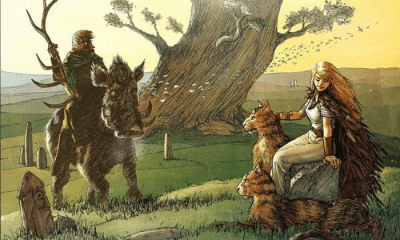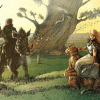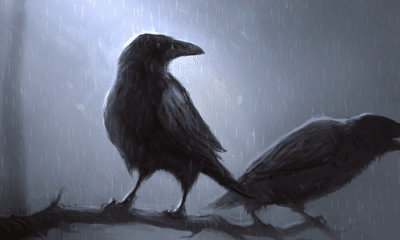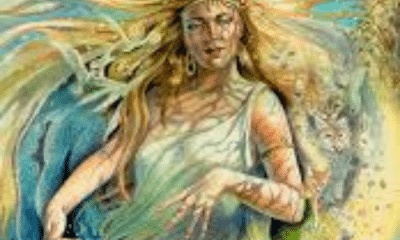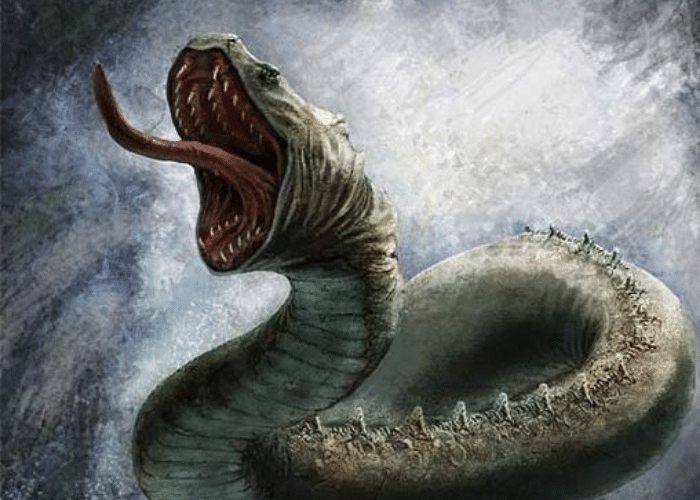
Norse
Jormungand: The Norse World Serpent
Jormungand: The Norse World Serpent
The great serpent that encircles the world is an iconic monster of Norse mythology, but how much do you really know about Jormungand? From his feud with Thor to his ancient origins, keep reading to learn all about the famous and ferocious Midgard Serpent!
Sailors in the Viking Age had more to fear from the sea than just storms and waves.
They believed that far beneath the surface, a massive monster lurked. This beast was so enormous that it encircled the entire world, biting its own tail to form a complete ring around the sea.
This was Jörmungandr, usually Anglicized as Jormungand. One of Loki’s monstrous offspring, he lived in the deepest parts of the sea and waited for his time to rise to the surface once more.
He would have his chance at Ragnarok, the battle that was prophesied to be the end of the world and of the gods. When he rose out of the sea, he would bring a wave of destruction and engage in an epic battle of strength and fortitude.
While this story is iconic in Norse literature, scholars believe that its origins lie far from Scandinavia. From Egypt to Greece, evidence of the themes that influenced Jormungand show that the World Serpent may be one of the oldest figures in Norse mythology.
Jormungand: The Enemy of Thor
According to Norse legends, Jormungand was the middle child of Loki and the giantess Angrboda.
He and his siblings, Hel and Fenrir, were born without the knowledge of the gods. When Odin and the other gods discovered Loki’s monstrous children, they immediately recognized them as a threat.
The half-rotten girl Hel was banished to the Underworld, where she became its ruler. The gods tried to tame Fenrir, the giant wolf, but were eventually forced to bind him with heavy chains.
Jormungand was given an even less dignified imprisonment. Thor picked up the young serpent and tossed him into the sea that surrounded Midgard.
Jormungand grew larger and larger. The sea was so vast that there was nothing to constrain his size.
Eventually, the serpent became so large that his body wrapped all the way around Midgard. The great serpent encompassed the entire world of men and wound his way unseen in the depths of the sea, growing so large that he gripped his own tail to make a complete circle around the sea.
Jormungand would not be totally forgotten beneath the waves, however. At least two stories featured him, both of which involved Thor.
In the first, Thor encountered a giant king named Skrymir, or Utgarda-Loki. The enormous giant challenges Thor and his companions to numerous feats of strength, each of which hides a secret.
When asked to race against a small boy, for example, Thor’s servant is actually racing against the speed of a thought. Loki’s eating contest was against wildfire, which can consume entire forests in minutes.
Thor’s first test was to lift Skrymir’s pet cat. The powerful god thought nothing of the challenge, but with all his effort was only able to lift one of the creature’s paws into the air.
When the details of the contests were revealed, the giant said that he was amazed at Thor’s strength. The cat had actually been Jormungand in disguise, so even lifting a fraction of the serpent’s immense weight was a feat.
Thor later encountered the sea serpent on a fishing trip with another giant named Hymir. Unaware of what Thor was hoping to catch, the giant was shocked when the god used an ox’s entire head as bait.
Miles from shore, much farther out to sea than Hymir was comfortable being in his small fishing boat, Thor got a bite. He strained and struggled to pull his massive quarry to the surface.
Hymir was terrified when Jormungand’s enormous head broke the surface. As Thor reached for his great hammer, Mjolnir, his companion was overcome with fright.
In a panic, Hymir lashed out with his knife and cut the fishing line. Jormungand slid back beneath the waves before Thor could strike it.
Thor was furious. He knew something Hymir did not – that the great Midgard Serpent would play a terrible role in the events to come.
The final appearance of Jormungand in mythology would also be the last appearance of Thor. They would meet for the last time at Ragnarok.
One of the events that would directly precede the final battle of the gods would be the great serpent pulling himself onto land. By that point he would be so enormous that mountains would be crushed by his weight and entire nations would be drowned beneath the tidal waves he caused.
During the battle, Jormungand and his siblings, along with their father and other allies, would be pitted against the Aesir gods. According to the Prose Edda’s account of the battle, each of Norse mythology’s most famous giants would go head to head with one of its greatest gods.
Jormungand would fight against the god he had encountered several times before, Thor.
The two would fight bitterly, each lashing out with all their enormous strength. In the end, however, Thor and his famous hammer would prevail and he would strike the World Serpent down with one final blow from Mjolnir.
After defeating Jormungand, Thor would turn to see his father losing ground in his fight against Fenrir. He would advance to help Odin battle the wolf, but would fall after just nine steps.
Although Jormungand would die at Thor’s hand, he would ultimately kill the god as well. His potent venom would end Thor’s life just moments after the serpent himself fell dead on the field of battle.
My Modern Interpretation
Jormungand is an example of one of Norse mythology’s most prevalent themes. His is one of many bound monsters who were destined to someday break free.
In fact, the serpent’s entire family fit this archetype. Fenrir and Loki were both bound with chains while Jormungand and Hel were sent to places that were difficult to break free of.
Many other bound monsters appear in the story of Ragnarok, although some scholars believe that monsters like Garm and Nidhogg were later additions to the story. The monstrous brood of Loki, including Jormungand, were the original bound monsters who would destroy the gods.
Among even them, however, some historians believe that the story of Jormungand and his banishment to the sea may be the oldest.
Many ancient cultures used similar bound monsters in their mythologies to explain natural phenomena. In Greece and Rome, for example, local volcanoes were sometimes said to be the result of buried giants.
Some historians believe that the Midgard Serpent may have originated as a similar explanatory legend. The movements of the snake and its attempts to free itself from the sea may have been seen as the cause of earthquakes and tidal waves, as it was in the Prose Edda’s account of Ragnarok.
For the Norse people, who primarily lived by the coast and traveled extensively across the sea, it made even more sense for such a threatening beast to live beneath the waves. Most cultures that bordered the sea had similar stories of menacing creatures that lurked in the dark depths.
Many of these even took on a similar form to Jormungand.
The ouroboros is a form that dates back to ancient Egypt. The snake biting its own tail in an endless loop is seen in many cultures as a symbol of eternity, the cycle of life and death, and of both rebirth and destruction.
In the Bible, the Leviathan is described as a massive sea monster that holds its own tail in its mouth. The Romans interpreted it as a symbol of the year’s cyclical nature.
Germanic images of the encircling serpent appear early enough to make it unlikely that they were inspired by the Roman and Christian influences of the Middle Ages, however. Instead, Jormungand seems to come from a more ancient source.
It seems likely that the image of the serpent was adopted into proto-Germanic culture early, probably from contact with Near Eastern and Egyptian culture or art. It persisted through hundreds of years and became incorporated into the developing Germanic, and later Norse, religions.
Jormungand is an iconic Norse monster, but its origins were in cultures far from Scandinavia. As a bound monster, explanation for disasters, and form of the ouroborus the Midgard Serpent shares a lineage with many monsters from other civilizations.
In Summary
According to Norse writers, the great serpent Jormungand was one of the three children of Loki and Angrboda. Cast into the sea when he was discovered, he eventually grew so large that he encircled the entire world.
Thor would encounter the great serpent three times in various legends. In two of these, he matched himself against the enormous monster’s strength and, in one case, nearly defeated him.
Their final encounter would be at Ragnarok, however. They would meet in a one-on-one battle after Jormungand destroyed much of the world by hauling his massive frame out of the water.
Thor would manage to kill the serpent, but would take only nine steps before falling down himself. Although Jormungand died, his venom soon killed the god he had been pitted against in all his stories.
Historians see many possible influences in the development of Jormungand.
He is one of several bound monsters that appears in the legend of Ragnarok, including his siblings and father. This also links him to stories from around the world of imprisoned monsters or giants who are responsible for natural disasters like earthquakes and tidal waves.
He is also a sea monster, a tradition that exists in most coastal cultures around the world. Representing the dangers and mysteries of the deep, such monsters were a source of dread and superstition in many civilizations.
Jormungand’s specific form may be inspired by a creature that was often referenced in ancient cultures of the Near East and the Mediterranean. The ouroboros, the snake swallowing or biting its own tail, originated in Egypt and spread through Europe through Greek and Roman influences.
While Jormungand is an iconic monster of Norse mythology, therefore, he is not entirely Scandinavia. The World Serpent represents traditions that truly go around the entire world.


